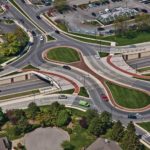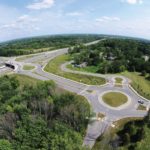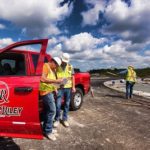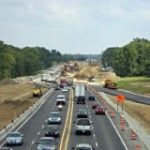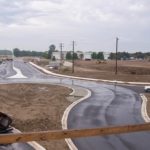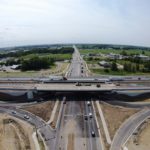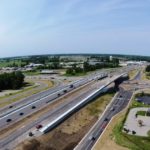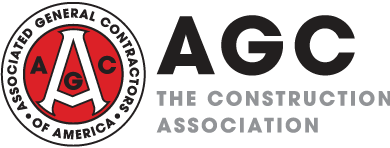- Company: Rieth-Riley Construction Co., Inc.
- Industry: Transportation
- Location: Indianapolis, Indiana
- Expected Completion Date: October 15, 2015
- Project Website
U.S. Route 31 runs from Spanish Fort, AL, to Mackinaw City, MI. The 266 miles of U.S. 31 that lie within Indiana serve as a major north/south conduit for the state. This highway runs through the heart of the state-directly through Indianapolis, and is the main artery to Indianapolis from the north through the suburb of Westfield. While the pavement was in need of resurfacing, there was a higher purpose in the reconstruction of this segment through this fast growing region. Westfield has experienced a population growth of 86% since 2000, along with many businesses, housing complexes and restaurants to support this tremendous growth. Significant developments were recently made included the opening of the city’s 400-acre Grand Park Sports Complex in 2014, accessible via this project.
When originally built, the highway was mostly constructed through rural areas. As the city grew, homes, businesses, and many stoplights sprouted along the highway until a congested and hazardous road required something to be done. The solution was to convert the highway to a limited access highway and making significant improvements to the crossroads and access roads for the adjacent homes and businesses.
The major reconstruction of U.S. 31 by Rieth-Riley Construction Co., Inc., which is celebrating its 100th year in construction, required hundreds of parcels to be purchased from public and private entities, as well as major utility relocation and upgrades. To accomplish this task, the road had to be elevated over 25 feet in some areas, as well as accommodate the many businesses and residences along the route during construction.
Rieth-Riley started the first of its three US 31 INDOT projects in Westfield on March 1, 2013 and was just recently completed in mid-October 2015. It is estimated 50,000 vehicles flow through this section every day. During construction, we averaged 45 employees and 5 subcontractors on site each day of construction.
Rieth-Riley completed nearly 75% of the $130 million projects with its own labor force and equipment. One of the first steps of the project was removing 2 million square feet of a combination of asphalt and concrete pavement. The concrete and asphalt was processed then reused in the fill below the new pavement. This, like the majority of the project, was completed in two different phases, southbound then northbound.
After the pavement was removed, 1 million cubic yards of dirt/structural backfill was imported to the site to build up the grade nearly 25 feet to carry the new U.S. 31 over eight intersections previously controlled by traffic signals. The imported dirt was retained at the bridges by 490,000 square feet of mechanically stabilized earth (MSE) walls. The final layer of dirt below the 14 inches of asphalt was treated with cement.
Rieth-Riley completed all phases of the construction at 8 of the 11 bridge locations between the three contracts. Some bridges were carrying U.S. 31 over the crossroads or other waterways. For other intersections, the crossroads were over the highway in the form of elevated roundabouts to further eliminate traffic delay and enhance safety.
New drainage was also installed throughout the four miles to accommodate the drastic elevation changes of the highway.
The U.S. 31 project was a great success in that it met the objectives of INDOT and the traveling public. The project added to Rieth-Riley’s 100 year reputation as a contractor capable of handling such large, complex and time-critical projects.
What impact does this project have on America?
The U.S. 31 project in Indianapolis had far reaching impacts on the country. First and foremost, the funding of the project was a result of (at the time) the revolutionary concept of P3 funding-a private investor entered into a lease with the State of Indiana for the Indiana Toll Road, resulting in billions available for large scale projects public projects such as this.
The project also impacted hundreds of thousands of commuters through this area in the most important location-near their homes and local places of business. This project was in the heartland of America and directly impacted lives.
The project had far reaching effects displaying how multiple public entities can work together effectively with the many private interests. It was truly a partnership of the public in the form of commuters, residents and businesses, the City of Westfield, INDOT, and Rieth-Riley.
Further, the transition to a limited access highway has saved an estimated average of 15 minutes off a traveler’s time through this stretch, resulting in not only time savings, but fuel savings and improved safety on this important highway. Much attention also went into the beauty of the project, including ornate MSE wall, planting of native grasses and trees, colored concrete and unique signage to enhance the travel experience.
What interesting obstacles or unusual circumstances did you overcome to complete the project?
Traffic control was a major consideration in this reconstruction project. Commuters on U.S. 31 move through one of the busiest access routes in the city. The project also ran beside a large high school, which was also undergoing significant construction, requiring coordination of efforts.
Significant effort was taken to notify and work with the local residents and businesses to lessen the impact during construction. Pre-planning had to be coordinated to lessen the impact for local events, such as the annual running of the Indianapolis 500.
Because of the high number of adjacent landowners and multiple utilities involved, the City of Westfield, INDOT and Rieth-Riley had to continually make scheduling adjustments as sections became available.
The most complicated potion of the project’s traffic control was the construction of SR 32 crossroad intersection-which contains very heavy traffic in all four directions. Five phases were required to rebuild SR 32, ¼ mile on each side of U.S. 31, in order to keep traffic flowing through Westfield’s busiest intersection. One unusual challenge encountered was constructing the road over a large high pressure gas line. Concerns that the pipeline would be under 25 feet of structural backfill and not carry the weight. The solution was finding an unusually lightweight yet strong material-Haydite, which weighs about 1/3 of our typical backfill material. Haydite is a unique, lightweight aggregate prepared by expanding shale, clay and slate at temperatures over 2200 degrees Fahrenheit. All the materials required to produce the Haydite are native to Indiana, but included a significant haul to the source.
Trucking shortages also became a problem at times as there was significant fill for the raised bridges. The U.S. 31 project was the largest active job in Indianapolis at the time.
The high profile nature of the project within the company and the community gave a sense of pride to all involved.
What dangers and risks did you encounter, and describe any extraordinary methods used to keep workers safe?
Daily, there was a large volume of traffic flowing through the construction site from multiple entrances and exits. With an ever-changing jobsite as sections were acquired/utilities relocated, the risks had to be continually assessed and managed.
Another significant risk was the elevating one side of the highway while the other carried live traffic. Great efforts were taken to ensure the safety of our employees, subcontractors and the traveling public. Efforts such as delineating risks of overhead power lines, identifying new employees on the jobsite, requiring all vehicles be parked at designated parking areas and backed into parking spaces, daily safety assessments and identifying hazards with the crew daily, and morning stretching exercises, the results were an excellent safety record much lower than the industry averages.
How did you leverage new technologies to work faster and reduce waste?
During the project, Rieth-Riley utilized HCSS’s mobile Heavy Job software to obtain real-time data which allowed our site supervision to make construction decisions immediately, as well as provide remote data access and data entry. We credit this software to substantially assist this complex multi-year project, enabling the project to go smoothly.
In addition, Rieth-Riley utilized heavy equipment with GPS systems. Dozers, graders and excavators equipped with GPS were used to more efficiently handle dirt and stone. Our GPS robotics were used to establish line and grade for precise concrete and asphalt placement. This project’s use of GPS controls resulted in more accurate and timely results.
With so many subcontractors, suppliers, multiple utilities, commuters, businesses, residents and multiple public entities involved, a website was maintained to help track and notify progress and upcoming activities/closures. In addition, the continual changes to design required an separate site be maintained for the appropriate entities involved in design/construction to coordinate schedules, plan design changes, etc.
Such technologies helped communication and efficient construction throughout the project, saving time and cost.
